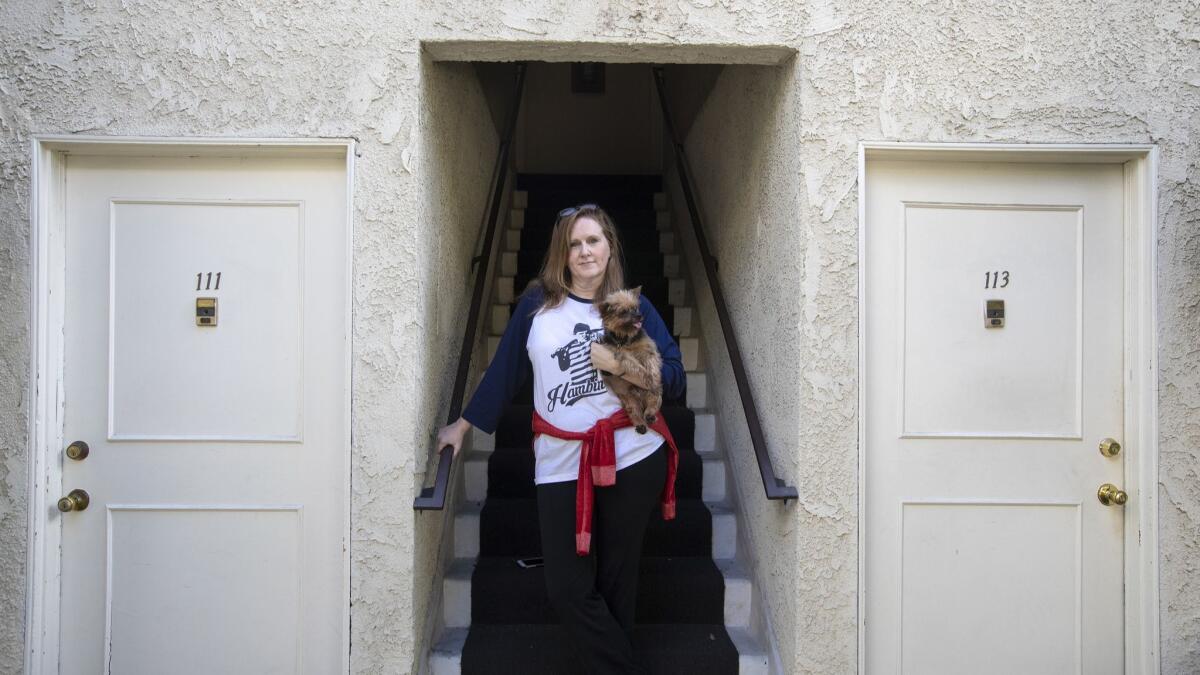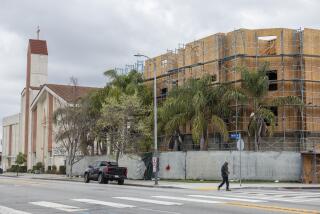In a rarity, Los Angeles strips building from rent control, leaving tenants facing big increases

In November, Californians will go to the polls to decide whether to give cities the option of sharply expanding protections against steep rent increases. But as tenants at a 38-unit Tarzana apartment complex recently discovered, it’s also possible to have existing rent controls revoked.
The property on Reseda Boulevard fell under the city of Los Angeles’ rent control ordinance, which also provides tenants assurance they can’t simply be kicked out as long as they follow the rules. Then last year, the protections disappeared.
For the record:
10:50 a.m. Oct. 6, 2018A previous version of this story said Morris is a part-time bookkeeper. She is a freelance bookkeeper.
Now the tenants face large rent hikes.
“You can see the slide coming,” said tenant Holly Morris, who is facing a 40% bump next month. “You really start looking at the people in the Winnebagos and thinking, ‘Wow, they were probably like me at one point.’”
The rare stripping of rent protections stems from a dispute between the city of Los Angeles and owner JKP Apartments over whether the Tarzana property was built two weeks after the 1978 cut-off date for rent control.
The case highlights an issue before voters in November — unmovable cut-off dates for rent control.
Its outcome appeared to ultimately hinge on competing interpretations of a 40-year-old building record. The housing department changed its rent-control determination at least twice before JKP threatened to sue the city for wrongly subjecting it to price caps. The city settled before JKP sued, agreeing to forever exempt the building from rent control.
Larry Gross, the executive director of the Coalition for Economic Survival, who pushed for rent control’s passage in 1978, said this is the first time he’s seen a building removed from the ordinance because the landlord disputed its age. He said the loss of protections is concerning because the city is already losing 5.5 rent-controlled units a day to demolitions and condo conversions.
The decision had somewhat predictable results. An attorney for the owners said that with new, higher rents it is feasible to make improvements to the aging property.
Greg Kirakosian, an attorney for JKP Apartments — who is related to the owners through marriage — said his family isn’t a greedy landlord. He said most tenants haven’t complained over the increases, which have made various improvements possible, including parking lot repairs, new security cameras and landscaping.
The owners also plan to power wash and repaint the building and begin an earthquake retrofit, Kirakosian said.
“It’s not like we are pocketing the cash,” he said. “We are using a large percentage of that money and putting that back into the building for the tenants.”
Morris said most residents are too afraid of retaliation to complain, particularly because strong eviction protections no longer exist. She and others said they don’t notice much improvement to the property, nor is the landlord quicker to respond to repair requests.
In August, several tenants sued JKP Apartments and the city to regain protections and reverse the sharp increases.
“With the housing crisis going on wouldn’t they bother to put up a fight?” said Morris, who helped organize tenants.
The Housing and Community Investment Department declined to comment. City attorney spokesman Rob Wilcox, citing attorney-client privilege, declined to say why the city settled but said in an email, “there were factors leading the city to deem the settlement the best course of action.”
Among the worried tenants is Laher Pour, an 85-year-old who lives on a fixed monthly budget of only $927, according to the complaint. In July, her rent jumped 42%, from $592 to $838. When she found out, she cried “uncontrollably” and worried she would become homeless, the lawsuit says.
Her brother, Bijan Fereybouny, said he is helping his sister, who hardly speaks English, navigate the increase. That includes helping her pay the rent. He’s not sure how long he can continue.
Kirakosian said units are still priced below what many nearby landlords charge, particularly Pour’s one-bedroom.
“If we looked at this only in financial gains, we would have raised the rents all the way to fair market value and she would have had to vacate,” Kirakosian said. “We care for these tenants and try to be respectful of their needs.”
At the heart of the controversy is whether the building is old enough to qualify for rent protections.
November’s Proposition 10 would repeal the state’s Costa-Hawkins Act, which restricts the age at which municipalities can extend rent control to buildings. Generally, owners of Los Angeles apartment buildings built on or before Oct. 1, 1978, can charge whatever rent they want for vacant units. But once a tenant moves in, they face limits on rent increases, usually capped at 3% a year.
Owners of buildings built after Oct. 1, 1978, generally face no restrictions on increases. The cutoff date exists to encourage construction and avoid exacerbating the housing crisis.
It’s unclear exactly why the city previously believed the building should be under rent control. But the determination is usually made by the date on which a certificate of occupancy or temporary certificate of occupancy was issued. Those documents mean the city has allowed residents to move in.
Los Angeles issued a certificate of occupancy to the then-owners of the Reseda Boulevard building on Oct. 16, 1978. Years later, the current owners discovered the document and in May 2016 sought to have the housing department remove rent restrictions, Jerie Petrosian, one of the owners, wrote in a sworn declaration.
The department initially agreed. But the department reversed itself after Gross reached out on behalf of Morris, who said she found a document on microfiche dated Feb. 16, 1978. She said Building and Safety workers told her it was a temporary certificate of occupancy. The city reversed itself in July 2016 and told the owners the building was rent controlled, citing the same reason.
The owners said they pulled records after the city’s reversal but could only find a “Request for Modification of Building Ordinances” dated Feb. 16, 1978. Petrosian’s declaration said Building and Safety employees confirmed the document — the same one Morris found — was not a temporary certificate of occupancy. The owners threatened to sue.
The city responded that it made another mistake and reversed course yet again, removing the property from rent control before it settled the owners’ claims for wrongly subjecting the building to price caps for decades, according to the declaration.
Tenants lost a motion for a temporary restraining order to reverse the increases, but are still trying to overturn the city’s decision in court. They cite a clause in the settlement where the city maintains that “evidence supports the contention” the property was issued a temporary certificate of occupancy on Feb. 16, 1978, and thus is subject to rent control.
To further the argument, tenant attorney Noah Grynberg noted the document under question says “temporary certificate of occupancy” under the “request” section and a box that indicates the department granted it is checked.
Morris believes if there was a basis for keeping the building out of rent control, the original owners would have fought tooth and nail to exempt it 40 years ago. And Grynberg said other records show the building is old enough to be under rent control.
Kirakosian disputed that and called the settlement language standard. City attorney spokesman Wilcox declined to comment on the rent control status but said that “all parties will be meeting in the near future to explore potential resolution of the case.”
For now, Morris, a freelance bookkeeper, is looking for a better job to more easily afford her rent increase of nearly $350 a month. She can make the increase work for now, but she worries future jumps may force her from her home.
“It’s like you are on a four-legged stool and someone took out a leg,” she said. “You lost your stability.”
Follow me @khouriandrew on Twitter
More to Read
Inside the business of entertainment
The Wide Shot brings you news, analysis and insights on everything from streaming wars to production — and what it all means for the future.
You may occasionally receive promotional content from the Los Angeles Times.











